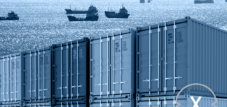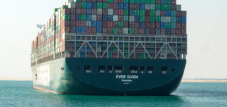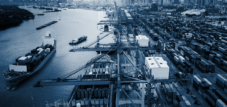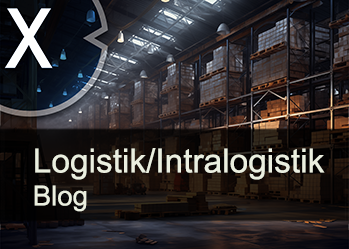Nearshoring: When global crises meet fragile supply chains, necessity turns into innovation
Xpert pre-release
Language selection 📢
Published on: October 16, 2025 / Updated on: November 26, 2025 – Author: Konrad Wolfenstein

Nearshoring: When global crises meet fragile supply chains, necessity turns into innovation – Image: Xpert.Digital
Delivery warehouse / provision warehouse as pre-buffer zone with container high-bay warehouse solution for production logistics
Is your production vulnerable? From space hog to efficiency miracle: How to create maximum resilience with high-bay containers
The modern manufacturing industry is facing a fundamental transformation of its logistics strategies. For decades, the just-in-time philosophy was considered the gold standard for efficient production, but fragile global politics and recurring disruptions to global supply chains have revealed a weak point that makes production sites worldwide vulnerable. In this tension between efficiency and resilience, an innovative solution is emerging that combines the best of both worlds: the container pre-buffer warehouse as the first line of defense against production stoppages. This interim storage station, which combines port logistics technology with high-bay warehouse systems, marks a paradigm shift in industrial materials management.
From the break-bulk era to the vertical container revolution
The history of containerization began in 1956, when American entrepreneur Malcolm McLean transported 58 containers from Newark to Houston in a converted tanker, ushering in the era of the standardized freight container. This seemingly simple innovation dramatically reduced transport costs and accelerated loading times from days to hours. In the 1960s, the International Organization for Standardization (ISO) established uniform container dimensions with the ISO 668 and ISO 1496 standards, with the 20-foot container (TEU) and the 40-foot container (FEU) becoming global standards. The maximum gross weight capacity has been gradually increased over decades, from an original 24,000 kilograms for 20-foot equivalent units to the current 36,000 kilograms for all standard containers.
The break-bulk era refers to the period in world trade and port handling before container transport became widespread – i.e., until roughly the 1960s.
"Break bulk" literally means "general cargo" or "broken cargo." In this era, goods were loaded onto ships individually, loose, or in smaller units (e.g., sacks, barrels, crates, bales).
Characteristics of the break-bulk era:
Manual work: Loading and unloading was mostly done by hand or with simple cranes.
High time expenditure: Loading a ship could take days or weeks.
High costs and risks: Goods were more vulnerable to damage, theft, and delays.
Many small storage areas in ports because each cargo had to be sorted individually.
The 1970s and 1980s saw rapid expansion, as major ports such as Rotterdam, Singapore, and Los Angeles upgraded their container handling infrastructure, laying the foundation for the global trade network. At the same time, warehouse technology evolved from simple floor storage to sophisticated systems. The introduction of forklifts, pallets, and conveyor belts in the 20th century revolutionized material handling. Automated storage and retrieval systems enabled more efficient inventory management and laid the foundation for today's high-bay warehouses, which reach heights of 12 to 50 meters and offer maximum flexibility through multi-depth storage.
The real revolution, however, began when a German mechanical and plant engineering company with 150 years of experience in the metals industry applied its proven high-bay racking technology for steel coils weighing up to 40 tons to port logistics. This technology, originally developed for the automated, 24/7 handling of metal coils in racks up to 50 meters high, formed the basis for a joint venture between a global port operator and the German technology company. After successful tests with over 63,000 container movements at a terminal in the Port of Jebel Ali in Dubai, the system was ready for market. The first commercial installation is being built at a Newport Terminal in South Korea and is expected to eliminate 350,000 unproductive movements per year and improve truck service times by 20 percent.
This technology overcomes the fundamental limitations of traditional container storage. While conventional yards stack containers directly on top of each other at a maximum of six levels, requiring restacking every 30 to 60 percent of all container movements, high-bay storage technology enables vertical stacking up to eleven or even eighteen levels with direct access to each individual container. Each container is assigned an individual rack location in a steel structure, served by fully automated electric storage and retrieval machines integrated into the structure. The system triples handling capacity while reducing space requirements by 70 percent.
The interaction of buffer storage, pre-buffer storage and production process
To understand the function of a container pre-buffer warehouse, the concept of buffer storage in production logistics must first be clarified. A buffer warehouse is a storage area that connects two consecutive process stages and ensures smooth operations without interruptions in production, picking, or delivery. This intermediate storage enables rapid replenishment in the event of disruptions or last-minute changes in the process flow. A special feature of buffer warehouses is that products are generally not assigned to fixed storage locations and only remain in the warehouse for a short time.
The container pre-buffer warehouse is positioned as the first storage station before the actual buffer warehouse in the production chain. This upstream storage creates an additional safety layer, buffering material in containers as short-term inventory, ensuring continuous supply to production and avoiding interruptions. In the event of fluctuations in material supply or slower production steps in the lead-up, delays in the overall process can be compensated. The pre-buffer warehouse acts as a time and quantity equalizer between production stages, maintaining flexibility and delivery capability.
Production parts from overseas are transported by container overland to the company premises unopened in the pre-buffer zone and only when required are the production parts transferred from the container to the staging area
The terminological distinction between buffer storage, safety stock, and work-in-progress inventory is crucial. Buffer storage refers to the temporary storage area itself, while safety stock refers to the strategically maintained inventory level to absorb uncertainties in demand, supply, or delivery times. Work-in-progress inventory (WIP), on the other hand, encompasses partially finished products in the production cycle, including the raw materials already used, direct labor costs, and associated manufacturing overhead. Container pre-buffer storage can accommodate both raw materials and work-in-progress inventory, thus representing a hybrid solution that integrates various buffer functions.
Inventory management in buffer systems typically follows the FIFO (First In, First Out) principle, where the first items are stored and removed first. This ensures consistent storage times and minimizes loss of value due to aging or damage. However, in specific applications, the LIFO (Last In, First Out) principle can also be used when space savings and cost reduction take priority over product freshness. Modern warehouse management systems monitor inventory levels in real time, organize storage locations by receipt date, and automatically notify employees when products are ready for delivery or when inventory levels reach critical thresholds.
The integration of the container high-bay warehouse into this buffer architecture revolutionizes material availability. While horizontal and limited stacking of containers has previously been ineffective in terms of rapid and automated availability, a container high-bay warehouse enables full automation in exchange with the production warehouse (delivery warehouse / provisioning warehouse) without major problems. The storage and retrieval machines and shuttles perform storage and retrieval operations with consistently high speed and precision, often with lead times of only a few minutes until a requested item arrives at the picking station. Computer-controlled management virtually completely eliminates human error and leads to inventory accuracies of over 99 percent.
Resilience instead of pure efficiency in a fragile world order
The COVID-19 pandemic, the blockage of the Suez Canal, geopolitical tensions, and natural disasters have ruthlessly exposed the vulnerability of global supply chains. A good 90 percent of all goods are transported across the world's oceans, mostly in containers. In 2024, global container volume reached 183.2 million TEU, representing growth of 6.2 percent compared to 2023. Three months in 2024 each exceeded 16 million TEU, a historic record. The increase was largely driven by the Red Sea crisis, which led to diversions around Africa and caused global demand for TEU miles to rise by a remarkable 21 percent.
These volumes illustrate the extreme dependence of modern production on functioning maritime supply chains. The just-in-time strategy introduced by a major Japanese automobile manufacturer in the 1970s, which aimed to reduce storage costs by minimizing inventories and receiving goods only when needed in the production process, proved to be its Achilles' heel under these conditions. While JIT reduces waste and increases operational agility in stable environments, it requires precise coordination between suppliers, manufacturers, and freight forwarders, where any disruption in the supply chain can lead to production delays.
The paradigm shift from pure efficiency to resilience is reflected in the growing realization that optimal supply chain resilience cannot be achieved through a single lever, but only through the combination of several coordinated strategies. Companies must carefully manage the delicate trade-off between resilience and efficiency. Supply chain resilience refers to the ability of a system to absorb shocks and remain functional even during significant disruptions, while supply chain efficiency focuses on optimizing resources and minimizing costs under normal conditions.
Strategies for increasing resilience can be divided into two categories: dual-purpose levers that simultaneously improve the robustness and efficiency of a supply chain, and dedicated resilience levers that primarily focus on resilience. Dual-purpose strategies include supplier diversification across multiple geographic regions, investments in digital supply chain technologies with real-time tracking and predictive analytics, and the maintenance of strategic safety stocks and inventory buffers. This is precisely where container pre-buffer storage positions itself as a hybrid solution: It creates safety stock without the extreme capital costs of traditional space storage.
Increasing inventory to reduce risk typically leads to increased working capital and storage costs. This is where the key advantage of high-bay storage technology becomes apparent: vertical storage on a minimal footprint allows significant inventory volumes to be maintained without incurring corresponding space costs. In port areas where developable land costs between €2,000 and €3,000 per square meter, saving three hectares of space alone for 3,000 TEU of storage capacity results in a cost advantage of €60 to €90 million. This capital efficiency enables companies to increase their security of supply without disproportionately increasing the financial burden.
Supply chain resilience is measured using four key metrics: time to awareness (the time until a disruption is perceived), time to action (the time until countermeasures are initiated), time to recover (the time until full functionality is restored), and time to survive (the maximum period a company can survive without supplies). A well-designed container buffer storage facility significantly improves all four metrics: Automated inventory management with real-time reporting shortens time to awareness, direct material availability reduces time to action, decoupling from global supply chain dependencies accelerates recovery, and increased safety stock significantly extends time to survive.
LTW Solutions
LTW offers its customers not individual components, but integrated complete solutions. Consulting, planning, mechanical and electrotechnical components, control and automation technology, as well as software and service – everything is networked and precisely coordinated.
In-house production of key components is particularly advantageous. This allows for optimal control of quality, supply chains, and interfaces.
LTW stands for reliability, transparency, and collaborative partnership. Loyalty and honesty are firmly anchored in the company's philosophy – a handshake still means something here.
Suitable for:
Resilience instead of risk: Why companies are now investing in container buffers
Classic hybrid high-bay warehouse systems (pallets, wire mesh boxes) with integrated buffer function in the automotive and pharmaceutical industries
The automotive industry is one of the pioneers in the implementation of highly automated warehouse systems. A leading German car manufacturer invested in a six-aisle, double-deep, 35-meter-high high-bay warehouse at its site in southern Germany with a storage and retrieval capacity of up to 150 pallet cages per hour. The facility, which can store over 70,000 pallet cages on approximately 7,300 square meters, went into operation at the end of 2020 after just one year of construction and processes both full units and replenishment functions fully automatically. The fully automated connection to the existing electric pallet conveyor line significantly reduces throughput times for spare parts and ensures timely customer delivery. The expansion also increased the days of supply (DOS), minimizing the need for replenishment from remote warehouses.
Another German premium automobile manufacturer operates an 80,000 square meter high-bay warehouse complex with state-of-the-art storage and material flow technology at its global logistics center. The facility uses a combination of chain, hydraulic, and electric pallet conveyors to send picked parts directly to the high-bay storage areas. The warehouse operates according to the "goods-to-person" principle, with parts being brought to employees via automated delivery systems. With over 1.4 million square meters of storage space at multiple locations, the headquarters maintains approximately 500,000 different car and commercial vehicle parts and ships an average of over 40,000 shipments daily. During the COVID-19 pandemic, the global logistics center demonstrated extraordinary flexibility, particularly in the global supply of spare parts for vehicles in system-relevant sectors.
The Dutch automotive industry implemented a 20-meter-high high-bay warehouse for car bodies with 420 storage locations, which acts as a capacity buffer between the body-in-white and paint shop production areas. The production control system distributes the various car body types evenly across three storage aisles and minimizes the travel distances of the storage and retrieval machines by prioritizing storage locations near the exit. Three approximately 20-meter-high storage and retrieval machines serve the almost eight-meter-long aisles in 24/7 operation after the initial production phase. The use of so-called body bars as transport and storage aids, which are mounted on the underside of the car bodies and precisely follow their contours, ensures precise positioning and damage-free handling.
Cold chain logistics is becoming increasingly important in the pharmaceutical sector. While 17 percent of global pharmaceutical transport was carried by air freight in 2000, this share fell to 11 percent by 2013. In 2018, 0.5 million tons of pharmaceutical goods were transported by air, while 3.5 million tons were shipped. The reason for this trend lies not only in costs but also in temperature deviations. The World Health Organization defines a temperature deviation as an event in which a temperature-sensitive pharmaceutical product is exposed to temperatures outside the prescribed ranges for storage and transport. Historically, air freight has been significantly more susceptible to temperature deviations than road or sea freight.
For ocean transport, pharmaceutical companies are increasingly using reefer containers, which are designed to maintain the pre-chilled temperature of the cargo by distributing chilled air through T-shaped floor grates, creating a consistent and even airflow throughout the container. Modern reefers offer advanced features such as backup generators and controlled atmosphere technology. Integrating these specialized containers into high-bay container warehouses allows for maintaining temperature-controlled conditions while maximizing storage capacity and rapid access, which is essential for pharmaceutical production with its strict compliance requirements.
Future scenarios: digitalization, Industry 4.0 and adaptive systems
The future of container pre-buffer storage will be significantly shaped by their integration into Industry 4.0 and Logistics 4.0 concepts. Logistics 4.0 refers to the comprehensive digitalization and networking of all logistics processes and represents the fourth industrial revolution in the logistics industry. The cornerstone is the digitalization of information and the seamless networking of all participants within the supply chain, enabling real-time monitoring and control of goods flows and creating an unprecedented level of transparency.
The Internet of Things plays a central role in Logistics 4.0. Sensors and smart devices continuously collect data that can be used to optimize logistics processes. This ranges from monitoring storage conditions to optimizing routes in transport logistics. In the context of container buffer storage, this means integrating RFID tracking systems that monitor inventory in real time and smart contracts via blockchain technology that ensure that suppliers only deliver materials when production needs them.
Big data logistics and analytical decision-making leverage the flood of data generated by IoT devices and other sources. With the help of algorithms and artificial intelligence, this data can be used to identify patterns, optimize processes, and make informed decisions in real time. AI models analyze consumer behavior, supply chain patterns, and historical sales data to optimize production plans. In semiconductor manufacturing, this leads to Advanced Manufacturing Execution Systems (MES), which support advanced scenarios in semiconductor batching and visually and intuitively manage production orders based on their impact on flow and delivery performance.
Predictive analytics will transform the role of pre-storage buffer warehouses. Instead of reacting to material shortages, intelligent systems will anticipate demand fluctuations and proactively adjust inventory levels. Research shows that AI-powered demand forecasting in JIT environments can reduce storage costs by 20 to 30 percent while improving order fulfillment rates. The integration of digital twin technology enables real-time monitoring and simulation of warehouse operations before physical changes are implemented. The market for automated container terminals is expected to reach USD 20.3 billion by 2035, driven by advances in robotics, autonomous vehicles, and AI-driven logistics systems.
Autonomous mobile robots (AMRs) will make the integration between container high-bay warehouses and production areas more seamless. Scalable solutions with additional AMRs enable flexible staging positions and a standardized communication interface for connecting autonomous systems. Seamless data transfer through standardized interfaces such as IPC-HERMES-9852, IPC-CFX, and OPC UA ensures interoperable system architectures. The development of Manufacturing Operations Management (MOM) systems and corresponding management systems coordinates all elements of intralogistics and creates an integrated control level.
Regionalization and nearshoring trends will change the role of container pre-buffer storage facilities. While globalized supply chains will continue to dominate, geopolitical uncertainties and sustainability requirements are leading to a partial relocation of production capacity. Regional production networks with robust local buffer capacities combine the advantages of global procurement with increased security of supply. Container pre-buffer storage facilities at strategic locations between seaports and production centers will become critical nodes in these hybrid networks.
The development of empty container management will also gain importance. As container volumes grow, so does the challenge of empty container logistics. A leading port equipment manufacturer announced plans for a fully automated empty container stacking area at a major Asian port, capable of storing over 25,000 containers with high-density stacking up to 18 containers high. An intralogistics systems specialist announced the construction of a second container warehouse that will offer not only high-density storage and direct access, but also expanded access options for maintenance and operational requirements. These developments demonstrate that the technology is increasingly being adapted to address related logistics challenges.
Sustainability initiatives will shape future systems. The full electrification of automated cranes and the integration of photovoltaic panels on roofs will enable virtually carbon-neutral operations. The operators of the joint venture state their goal is to significantly support the decarbonization of the supply chain. Energy recovery systems, which recover the energy generated when lowering containers, will become standard. The combination of optimal space utilization, reduced land consumption, and renewable energies positions high-bay container warehouses as a sustainable alternative to space-intensive conventional yards.
The strategic reassessment of resilience as a competitive advantage
Container pre-buffer storage marks a fundamental shift in the understanding of supply chain management. The dichotomy between efficiency and resilience, considered insurmountable for decades, is being resolved through technological innovation. The vertical integration of proven high-bay storage technology from the steel industry with the standardization of global container transport creates a solution that combines both worlds: the capital efficiency of vertical storage with the security of supply of substantial buffer stocks.
The empirical data speaks for itself. With a threefold increase in handling capacity, 70 percent space savings, and the elimination of 350,000 unproductive movements per year, the technology demonstrates measurable operational benefits. The increase in quayside productivity of up to 20 percent and inventory accuracies of over 99 percent set new benchmarks for logistics performance. At the same time, the reduction in land costs by €60 to €90 million per 3,000 TEU of storage capacity enables financial flexibility that can be invested in additional resilience measures.
However, the role of the container pre-buffer storage facility transcends pure logistics efficiency. It represents a strategic repositioning in an age of increasing geopolitical uncertainty and climate-related disruptions. The ability to decouple production processes from the volatility of global shipping without sacrificing the benefits of international division of labor provides companies with decisive competitive advantages. In a world where time to survive and time to recover are becoming critical performance indicators, the pre-buffer storage facility acts as life insurance for production sites.
The diffusion of this technology is still in its early stages. While the first commercial facilities are being built in South Korea and test facilities have demonstrated their market readiness, broader adoption in the manufacturing industry will shape the coming years. Integration with Industry 4.0 technologies, particularly predictive analytics and autonomous intralogistics, will further enhance performance. The projected market value of USD 20.3 billion for automated container terminals by 2035 indicates significant market penetration.
Critical challenges remain. The high initial investment, technological complexity, and dependence on functioning automation require careful risk assessment. The balance between lean principles and resilience requirements must be calibrated individually for each industry and location. Sustainability aspects, especially the material footprint of additional steel structures and containers, must be included in overall considerations. The organizational requirements for staff training, process integration, and change management should not be underestimated.
Nevertheless, there is no question that container pre-buffer storage represents a key technology for resilient production networks in the 21st century. The convergence of port logistics innovation, high-bay storage technology, and intelligent automation creates an infrastructure that enables both current operational excellence and future adaptability. In an era where the only constant is change and the only certainty is uncertainty, those companies that will succeed are those that understand efficiency and resilience not as opposites, but as complementary dimensions of strategic competitiveness. Container pre-buffer storage is more than a technological solution—it is an answer to the fundamental question of how production can be secured in a fragile world order.
Your container high-bay warehouse and container terminal experts

Container terminal systems for road, rail, and sea in the dual-use logistics concept of heavy-duty logistics - Creative image: Xpert.Digital
In a world characterized by geopolitical upheavals, fragile supply chains, and a new awareness of the vulnerability of critical infrastructure, the concept of national security is undergoing a fundamental reassessment. A state's ability to ensure its economic prosperity, the supply of its population, and its military capability increasingly depends on the resilience of its logistics networks. In this context, the term "dual-use" is evolving from a niche category of export control to a overarching strategic doctrine. This shift is not merely a technical adaptation, but a necessary response to the "turning point" that requires the profound integration of civilian and military capabilities.
Suitable for:
Your global marketing and business development partner
☑️ Our business language is English or German
☑️ NEW: Correspondence in your national language!
I would be happy to serve you and my team as a personal advisor.
You can contact me by filling out the contact form or simply call me on +49 89 89 674 804 (Munich) . My email address is: wolfenstein ∂ xpert.digital
I'm looking forward to our joint project.
☑️ SME support in strategy, consulting, planning and implementation
☑️ Creation or realignment of the digital strategy and digitalization
☑️ Expansion and optimization of international sales processes
☑️ Global & Digital B2B trading platforms
☑️ Pioneer Business Development / Marketing / PR / Trade Fairs
Our global industry and economic expertise in business development, sales and marketing

Our global industry and business expertise in business development, sales and marketing - Image: Xpert.Digital
Industry focus: B2B, digitalization (from AI to XR), mechanical engineering, logistics, renewable energies and industry
More about it here:
A topic hub with insights and expertise:
- Knowledge platform on the global and regional economy, innovation and industry-specific trends
- Collection of analyses, impulses and background information from our focus areas
- A place for expertise and information on current developments in business and technology
- Topic hub for companies that want to learn about markets, digitalization and industry innovations
























